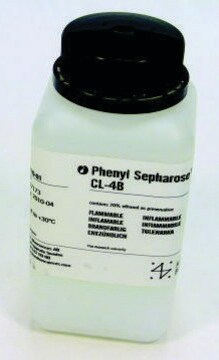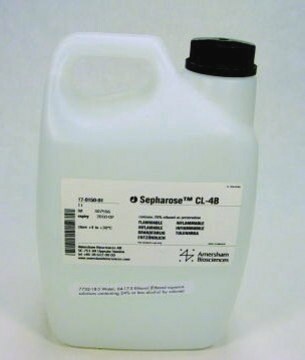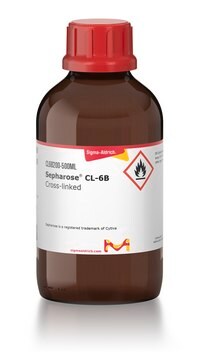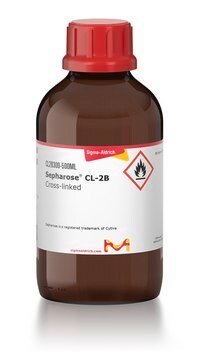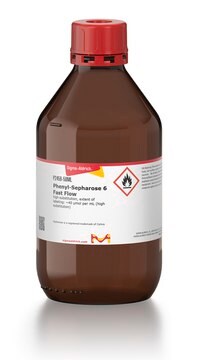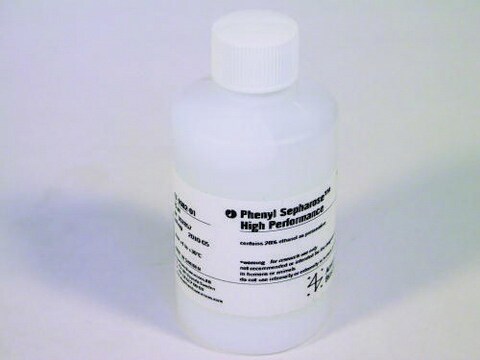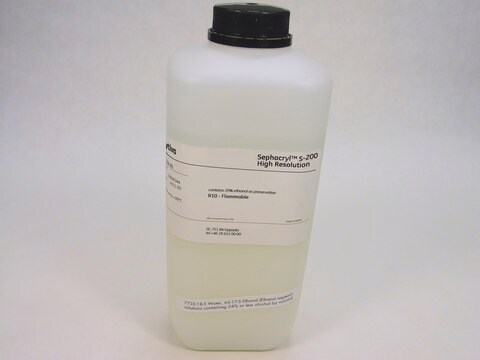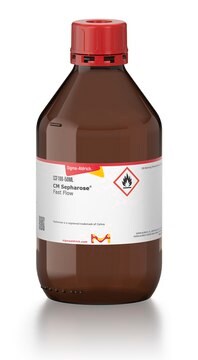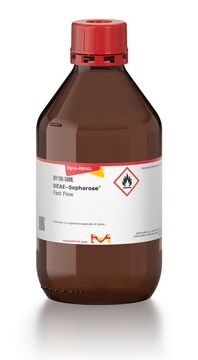P7892
Phenyl-Sepharose CL-4B
extent of labeling: ~40 μmol per mL
Synonym(s):
Phenyl-Agarose
Sign Into View Organizational & Contract Pricing
All Photos(1)
About This Item
Recommended Products
form
suspension
Quality Level
extent of labeling
~40 μmol per mL
matrix
agarose, 4% cross-linked
matrix activation
epichlorohydrin
matrix attachment
hydroxyl
matrix spacer
3 atoms
particle size
45-165 μm
capacity
15-20 mg/mL binding capacity (human serum albumin)
3-5 mg/mL binding capacity (β-lactoglobulin)
storage temp.
2-8°C
Looking for similar products? Visit Product Comparison Guide
General description
P7892-200ML′s updated product number is GE17-0810-01
Application
Phenyl Sepharose™ is used in protein chromatography, affinity chromatography, hydrophobic interaction media, resins and separation media. Phenyl Sepharose™ has been used in studies that contributed to improving industrial applications in additives in detergents and feed industries. Phenyl Sepharose™ has also been used to study microbial communities inhabiting hypersaline environments.
Physical form
Suspension in 20% ethanol
aqueous ethanol suspension
Legal Information
Sepharose is a trademark of Cytiva
related product
Product No.
Description
Pricing
Signal Word
Warning
Hazard Statements
Precautionary Statements
Hazard Classifications
Flam. Liq. 3
Storage Class Code
3 - Flammable liquids
WGK
WGK 3
Flash Point(F)
96.8 °F
Flash Point(C)
36 °C
Choose from one of the most recent versions:
Already Own This Product?
Find documentation for the products that you have recently purchased in the Document Library.
Customers Also Viewed
O Ploux et al.
The Biochemical journal, 283 ( Pt 2), 327-331 (1992-04-15)
The 8-amino-7-oxopelargonate synthase [6-carboxyhexanoyl-CoA:L-alanine carboxyhexanoyltransferase (decarboxylating); EC 2.3.1.47] from Bacillus sphaericus involved in biotin biosynthesis was purified from an Escherichia coli overproducing strain. The purification afforded an electrophoretically homogeneous enzyme with a specific activity of 0.67 unit/mg. The purified enzyme
Cui, W., et al.
Enzyme and Microbial Technology, 24(3-4), 200-208 (1999)
W Kroutil et al.
Journal of biotechnology, 61(2), 143-150 (1998-07-09)
A highly enantioselective, soluble epoxide from Nocardia sp. EH1 was purified to homogeneity via a four-step procedure: (i) hydrophobic interaction chromatography on Phenyl Sepharose CL-4B, (ii) anion exchange chromatography on SOURCE 30Q, followed by (iii) a second hydrophobic interaction chromatography
Sheref S Mansy et al.
Proceedings of the National Academy of Sciences of the United States of America, 105(36), 13351-13355 (2008-09-05)
The earliest cells may have consisted of a self-replicating genetic polymer encapsulated within a self-replicating membrane vesicle. Here, we show that vesicles composed of simple single-chain amphiphiles such as fatty acids, fatty alcohols, and fatty-acid glycerol esters are extremely thermostable
Sheref S Mansy et al.
Nature, 454(7200), 122-125 (2008-06-06)
Contemporary phospholipid-based cell membranes are formidable barriers to the uptake of polar and charged molecules ranging from metal ions to complex nutrients. Modern cells therefore require sophisticated protein channels and pumps to mediate the exchange of molecules with their environment.
Our team of scientists has experience in all areas of research including Life Science, Material Science, Chemical Synthesis, Chromatography, Analytical and many others.
Contact Technical Service
